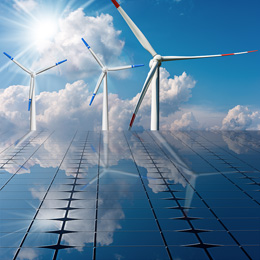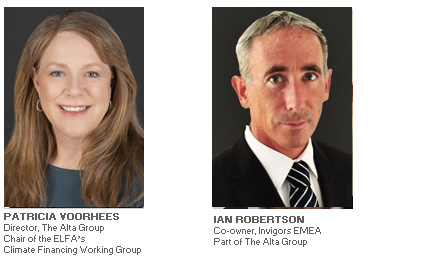
This is part one of a three-part series by The Alta Group on climate equipment finance covering market size, risk and strategy considerations followed by articles to address vertical opportunities from a global perspective, new business models and the latest efforts of industry leaders and associations to address this opportunity.
The financing of climate-focused equipment is a rapidly developing market segment that offers vast opportunity for equipment leasing professionals. This asset class has gained momentum amid an increasing number of climate-related disasters and geopolitical events that have driven demand for energy transition and mitigation solutions worldwide.
With billions of dollars currently being invested in R&D and future anticipated annual capital investment estimated to be in the trillions, the potential for our industry is massive.
Adding to the momentum are climate-related provisions of the federal Inflation Reduction Act of 2022 and the Glasgow Finance Alliance for Net Zero, formed in 2021 with hundreds of financial institutions with $113 trillion in assets across 45 nations to accelerate decarbonization of the economy.
Geopolitical events have drawn a critical consideration toward energy security— defined by the International Energy Agency as the uninterrupted availability of affordable energy sources. Russia’s invasion of Ukraine has forced other countries to examine their own policies regarding energy security and their ability to react to sudden changes in the supply and demand of energy resources.
What Is Climate Equipment Finance?
This asset sector targets equipment, services or projects that reduce carbon emissions or mitigate the environmental impact of excessive carbon dioxide (CO2) and other greenhouse gas emissions. Examples include equipment for energy efficiency, sustainable agriculture and transport, renewables and climate resilience.
Climate equipment categories include:
- Batteries and energy storage
- Electric vehicles (EVs) and EV charging units
- EVs for construction and material handling
- Photovoltaic cells (PVCs) and related solar-energy equipment
- Wind turbines
- LED lighting
- Water filtration
- Energy-efficient HVAC systems
- Smart technologies for energy efficiency in buildings, agriculture and industrial processes
The industry continues to evolve in response to market dynamics, customer demand and new technologies that promote the transition from fossil fuels. We expect to see greater development in infrastructure related to electrification and distribution, as well as equipment for bioenergy, hydrogen and carbon capture, utilization and storage (CCUS).
Structuring the Deal
At The Alta Group, we are helping clients develop custom financing solutions for manufacturers and vendors, including those in climate finance or planning to enter this market. Capital providers to the industry are seeking assistance developing investment strategies and transaction-based due diligence support. Many renewable-energy equipment financing deals may be traditionally structured as loans or residual-based leases, but there are other options to consider. For example, credit enhancements, commercial rebates and government grants are potential solutions, as are pay-per-use or pay-per-performance contracts.
Strategic assessment should address the following dimensions at a minimum:
- Overall scale of market opportunity
- Likely margins and competition
- Technology risk
- Credit base
- Ticket size (depends on financing structure)
- Maturity of market actors and financing in particular
- Tenor and payback for client (i.e., compelling client value proposition)
- Residual risk
- Sales cycle and opportunity for regular flow of business
- End user segment familiarity and complexity
- Regulatory constraints (license and/or legal concerns)
- Existing asset familiarity
- Make market or take market decisions
- Developer and partner strength
- Servicing and operational risks and concerns
- Market and merchant risk
- Reliance on tax advantages
- Essential use
- Moveable equipment (only critical for some geographies and credit quality)
- Performance risk considerations
- Vendor risk
- Disqualified industries or assets
- Reliance on tax credits and/or other incentives
Business model considerations
- Internal competencies
- Operational requirements
- Financial solution, e.g., special-purpose vehicle (SPV) model or more traditional leasing structure
Strategic planning should explore business models unique to this asset class. Subscriptions or usage models may work better in some categories of this market than in others.
Opportunity Versus Risk
New business models come with risk, and climate equipment is no exception. Nascent technology that is not broadly commercialized introduces performance risk factors sure to be a keen focus of investors and capital markets in coming years. Key questions will include whether the equipment delivered is what is expected, and whether it will perform at a high level and lead to the anticipated savings. Answering questions like these will require a keen understanding of how the assets are likely to perform. Risk mitigation structures should distribute risk among partners to coax investment while the technology matures.
Adding to the risk is that there may be more parties to these deals which makes them more complex as industry executives are also looking at how to share risks with vendors and, in some cases, government or non-profit entities.
Each organization should assess its existing expertise in risk and asset management. It is critical to have a clear understanding of market dynamics and regulatory factors. An entity that is heavily involved in transportation financing, for example, is likely suited to extend its strategy to commercial EVs and supporting infrastructure.
For many, the opportunities in energy-efficient equipment finance are compelling. To some industry players, this is a new market to be served that represents an opportunity for significant growth. Climate equipment will be developed and manufactured; it will likely be in demand on a global scale; and it can be financed. In some cases, the available government tax and rebate incentives drive the economic value proposition for lessees and lessors. In every case the bottom line is: It must make economic sense for all involved.
Other stakeholders—investors and employees—will favor companies that are demonstrating an authentic commitment to ESG (Environmental, Social and Governance) principles, not just talking about them. The Equipment Leasing and Finance Foundation’s 2022 report, “The ESG Imperative,” completed with research and analysis by The Alta Group, found that global ESG assets under management are expected to exceed $50 trillion by 2025—a significant increase from the 2021 figure of $35 trillion. A key insight from this report was that for the equipment finance industry, the growth in capital flowing to ESG assets is being driven both by funders and rating agencies, which are now including ESG inquiry in diligence efforts, and by capital providers that see equipment financing as an attractive area to grow their ESG investments.
Global companies are considering how other countries and governments are committing to ESG and taking note. Norway, for example, gained a reputation as a pioneer in the transition to EVs when it enacted legislation to ban the sale of gas-powered cars by 2025. The European Union this year approved a law banning the sale of gas-powered cars starting in 2035. In the U.S., the movement has only become more visible in recent years with political and societal pressures to act. For instance, California has passed legislation to ban the sale of new internal combustion engines by 2035, and six other states have announced they will follow California’s clean-car rules on the same timeline. While there is ample political debate over the timing and execution of the transition to EVs, there is little doubt that actions like these in populous states will impact the decisions of automobile manufacturers and purchasers.
A Prime Position
Our industry is in a prime position to create value through the delivery of financing solutions with positive environmental impacts. Now is the time to assess current capabilities and formulate a strategic plan to both capitalize on this nascent industry in its current form, and to evolve with it as innovation and growing market demand cause it to become an even larger piece of the overall equipment investment market.
Note: The Equipment Leasing and Finance Association created the Climate Financing Working Group in 2022 to determine the size of the market and provide education, best practices and government advocacy.
